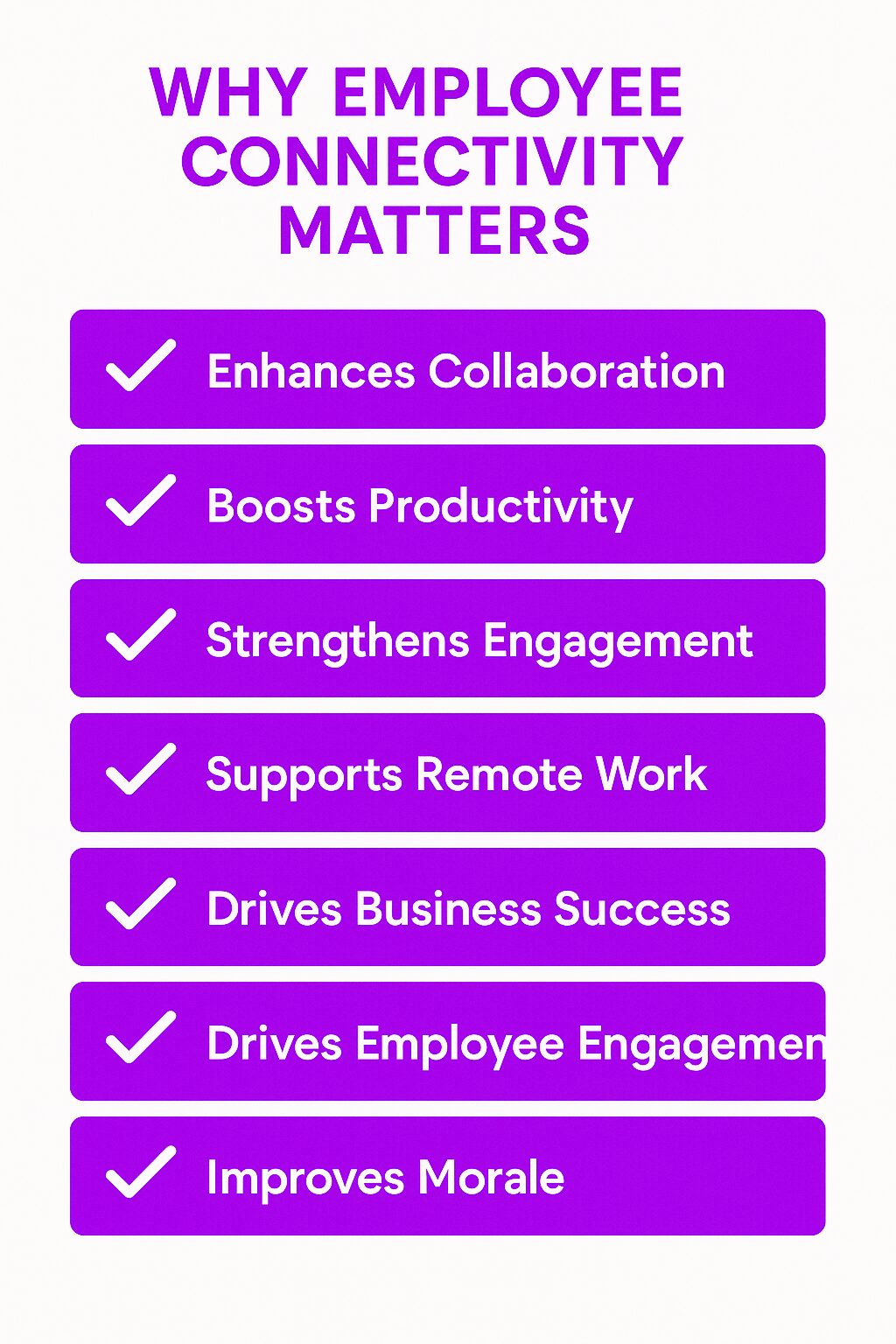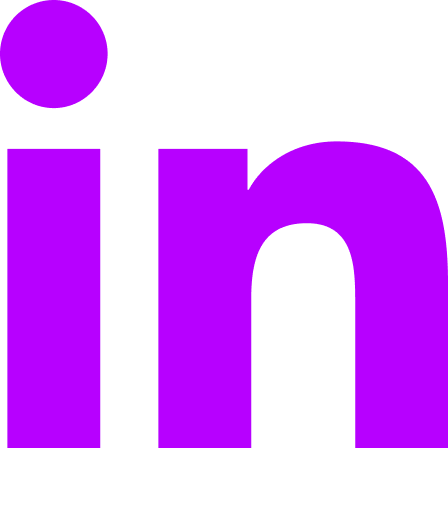What is Employee Connectivity?
Employee connectivity refers to the ability of employees to communicate, collaborate, and access essential information seamlessly within an organization. It includes digital tools, workplace culture, and leadership initiatives that facilitate engagement across teams. An employee engagement platform plays a crucial role in fostering communication and collaboration by enabling organizations to gather feedback, analyze engagement metrics, and create an effective employee engagement strategy that enhances employee relationships.
Why is Employee Connectivity Important?
-
Enhances Collaboration – Strengthens teamwork and knowledge-sharing.
-
Boosts Productivity – Provides seamless access to critical work resources.
-
Strengthens Engagement – Keeps employees connected to company goals and values.
-
Supports Remote & Hybrid Work – Ensures effective communication across locations.
-
Drives Business Success – Aligns employees with organizational objectives.
-
Drives Employee Engagement – Enhances motivation and commitment by keeping employees connected to the organization.
-
Improves Employee Morale – Fosters a sense of pride and purpose among employees, leading to higher satisfaction and loyalty.
Key Components of Employee Connectivity
1. Digital Communication & Collaboration Tools
Facilitates real-time interaction and teamwork.
Example: Using Slack or Microsoft Teams for instant messaging and project discussions.
2. Centralized Access to Information
Ensures employees can easily find company updates, policies, and documents.
Example: A cloud-based intranet like Simpplr for storing internal resources.
3. Leadership Engagement & Transparency
Encourages open communication between executives and employees. Leadership plays a crucial role in managing employee engagement by fostering open communication and embodying company values. Example: Regular town hall meetings where leadership shares company progress.
4. Employee Recognition & Inclusion
Fosters a connected culture by valuing employee contributions. Example: A peer recognition program highlighting team achievements. An effective employee engagement program is crucial for recognizing and including employees, thereby enhancing motivation and satisfaction.
5. Secure & Reliable IT Infrastructure
Supports seamless access to work tools without technical disruptions.
Example: Implementing VPNs and multi-factor authentication for secure remote connectivity.
Building a Positive Work Environment
A positive work environment is essential for fostering employee connection and engagement. When employees feel valued, respected, and supported, they are more likely to be motivated, productive, and committed to the organization.
Create a Positive Work Environment that Fosters Connection
Creating a positive work environment that fosters connection requires intentional effort and a deliberate approach. Here are some strategies to consider:
-
Encourage Open Communication and Transparency: Promote a culture where employees feel comfortable sharing their thoughts and ideas. Regular updates from leadership and open forums for discussion can help.
-
Foster a Culture of Inclusivity and Respect: Ensure that all employees feel included and respected, regardless of their background or role. Diversity training and inclusive policies can support this.
-
Provide Opportunities for Social Interaction and Team-Building Activities: Organize events and activities that allow employees to connect on a personal level, such as team lunches, outings, or virtual coffee breaks.
-
Recognize and Celebrate Employee Achievements and Milestones: Regularly acknowledge and celebrate the accomplishments of employees, both big and small, to make them feel valued.
-
Encourage Employee Feedback and Suggestions: Create channels for employees to provide feedback and suggestions, and act on them to show that their input is valued.
By implementing these strategies, organizations can create a positive work environment that fosters connection and engagement among employees.
Encourage Collaboration and Teamwork
Collaboration and teamwork are essential for driving business success and promoting employee engagement. When employees work together towards a common goal, they are more likely to feel motivated, engaged, and committed to the organization. Employee surveys can be a valuable tool for measuring employee engagement, job satisfaction, and areas for improvement within the workplace.
Here are some strategies to encourage collaboration and teamwork:
-
Provide Opportunities for Cross-Functional Collaboration and Knowledge Sharing: Encourage employees from different departments to work together on projects and share their expertise.
-
Encourage Employees to Share Their Ideas and Perspectives: Create an environment where employees feel comfortable voicing their opinions and suggestions.
-
Foster a Culture of Collaboration and Teamwork: Promote values that emphasize the importance of working together and supporting one another.
-
Recognize and Reward Team Achievements and Milestones: Celebrate the successes of teams to reinforce the value of collaboration.
-
Provide Training and Development Opportunities to Enhance Collaboration and Teamwork Skills: Offer workshops and training sessions that focus on building teamwork and collaboration skills.
By encouraging collaboration and teamwork, organizations can drive business success and promote employee engagement.
Promote Work-Life Balance and Well-Being
Promoting work-life balance and well-being is essential for driving employee engagement and retention. When employees feel supported and valued, they are more likely to be motivated, productive, and committed to the organization.
Here are some strategies to promote work-life balance and well-being:
-
Offer Flexible Work Arrangements and Telecommuting Options: Allow employees to have flexible schedules or work from home to better balance their personal and professional lives.
-
Provide Wellness Programs and Initiatives that Promote Employee Well-Being: Implement programs that focus on physical, mental, and emotional health, such as fitness classes, mental health resources, and stress management workshops.
-
Encourage Employees to Prioritize Their Well-Being and Self-Care: Promote a culture where taking care of oneself is seen as important and supported by the organization.
-
Recognize and Reward Employees for Their Contributions to the Organization: Regularly acknowledge the hard work and dedication of employees to make them feel appreciated.
-
Foster a Culture of Work-Life Balance and Flexibility: Lead by example and encourage managers to support their teams in achieving a healthy work-life balance.
By promoting work-life balance and well-being, organizations can drive employee engagement and retention.
Employee Connection and Engagement
The Link Between Employee Connection and Employee Engagement
Employee connection and employee engagement are two sides of the same coin, both crucial for cultivating a positive and productive work environment. Employee connection refers to the bond and relationship employees have with their organization, colleagues, and leadership. On the other hand, employee engagement is the emotional commitment and involvement employees feel towards their work, team, and the organization as a whole. When employees feel connected, they are more likely to be engaged, leading to enhanced teamwork, collaboration, and overall business success. This strong connection ensures that employees are aligned with the organization’s values and goals, driving motivation and commitment.
How Employee Connection Drives Employee Engagement and Leads to Highly Engaged Employees
Employee connection is a key driver of employee engagement. When employees feel a sense of belonging and loyalty to their colleagues, leadership, and company culture, they are more likely to be engaged and motivated. This connection fosters a supportive environment where employees feel valued and appreciated, leading to higher levels of engagement. Highly engaged employees are more productive, provide excellent customer service, and contribute significantly to the organization’s growth and success. By fostering strong employee connections, organizations can create a workforce of highly engaged employees who are committed to achieving business success.
Effective Employee Connection Strategies
Leverage Technology for HR Connectivity
In today’s digital age, technology plays a pivotal role in fostering employee connection and engagement. HR can leverage digital communication tools, such as employee engagement platforms, to facilitate seamless communication and collaboration among employees. These platforms serve as a centralized hub where employees can connect, share ideas, and provide feedback, enhancing their sense of belonging and engagement. Additionally, technology can be used to host virtual team-building activities, social events, and training sessions, which help build relationships and foster a sense of community among remote and hybrid teams. By implementing these effective employee connection strategies, organizations can improve employee engagement, productivity, and retention rates, ultimately leading to business success. Prioritizing employee connection and engagement, and leveraging technology to facilitate these aspects, is essential for creating a thriving workplace culture.
Best Practices for Improving Employee Connectivity
Step 1: Invest in Digital Workplace Solutions
Adopt collaboration tools that streamline communication and workflow.
Step 2: Foster a Culture of Open Communication & Employee Feedback
Encourage leadership transparency and employee feedback mechanisms.
Step 3: Ensure Seamless Access to Information
Centralize company updates and resources on an intuitive platform.
Step 4: Promote Employee Engagement & Recognition
Encourage team interactions and acknowledge contributions regularly. Employee engagement strategies are crucial in fostering a connected and motivated workforce. Additionally, a well-designed employee engagement survey plays a vital role in measuring and enhancing employee commitment and satisfaction.
Step 5: Continuously Monitor & Optimize Connectivity & Employee Engagement Strategies
Use employee feedback to improve communication channels and technology.
Employee Resource Groups (ERGs)
Employee Resource Groups (ERGs) are employee-led groups that promote diversity, inclusion, and employee engagement. ERGs provide a platform for employees to connect with each other, share their experiences, and support each other.
ERGs play a crucial role in fostering a sense of belonging and community within the organization. They offer employees the opportunity to engage with colleagues who share similar backgrounds or interests, which can enhance their overall work experience. Additionally, ERGs can drive employee engagement by providing a space for employees to voice their concerns, celebrate their cultures, and contribute to the organization’s diversity and inclusion efforts.
By supporting ERGs, organizations can create a more inclusive and engaged workforce, ultimately contributing to business success.
Best Tools for Enhancing Employee Connectivity
-
Simpplr – AI-powered intranet for seamless communication.
-
Slack – Instant messaging and team collaboration platform.
-
Zoom – Video conferencing for remote team engagement.
-
Employee Engagement Platform – A tool for gathering feedback, analyzing engagement metrics, and creating strategies to enhance employee relationships.
Frequently Asked Questions
How does employee connectivity differ from employee engagement?Connectivity focuses on communication and collaboration, while engagement involves motivation and job satisfaction. Employee engagement research plays a crucial role in understanding the dynamics of employee connection and motivation.
Which industries benefit most from employee connectivity?All industries, particularly those with remote, hybrid, or global teams.
How do you measure employee connectivity?By tracking communication effectiveness, employee feedback, and engagement levels.
Final Thoughts
Strong employee connectivity enhances collaboration, productivity, and workplace engagement. By leveraging digital tools, fostering transparency, and promoting inclusivity, organizations can create a more connected and efficient workforce.







